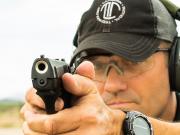Fair enough. So I checked out the first link, and in SSP, here is what I saw:
- Some people who shot more accurately than you, lost to you.
- Every person who beat you, shot more accurately than you.
- The guy who won the Division dropped the fewest points.
Now I suppose if you wanted to suggest that Ernest's comment (which you've now quoted twice) was meant in absolute terms, sure, you're right and he's wrong. But I'm pretty sure Ernest understands that someone taking an hour to score 100% hits at an IDPA match isn't going to be the winner. In context, as you like, the point was that poor hits hurt you a lot more in IDPA than in USPSA.
Let's look at that IDPA match you posted: You shot in a raw time of 68.67 seconds, far faster than the Division winner who did it in 75.22 seconds. But that raw speed wasn't enough to win the match even though you were faster than the best shooter. Pretty much demonstrates that speed alone won't win an IDPA match.




 Reply With Quote
Reply With Quote
 My first competition was in 1981 and I have been shooting IPSC/USPSA, IDPA, GSSF and other stuff since. I am also a reserve police officer for the local PD and I have been doing the firearms re-qualifications for the PD for 20 years or so.
My first competition was in 1981 and I have been shooting IPSC/USPSA, IDPA, GSSF and other stuff since. I am also a reserve police officer for the local PD and I have been doing the firearms re-qualifications for the PD for 20 years or so. 

 . Snarky and easily butt hurt. Favorite animal is the Cape Buffalo....likely indicative of a personality disorder.
. Snarky and easily butt hurt. Favorite animal is the Cape Buffalo....likely indicative of a personality disorder.

